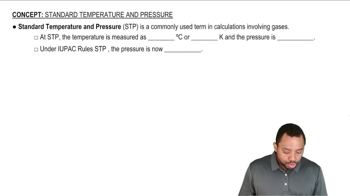4.00-g sample of a mixture of CaO and BaO is placed in a 1.00-L vessel containing CO2 gas at a pressure of 730 torr and a temperature of 25°C. The CO2 reacts with the CaO and BaO, forming CaCO3 and BaCO3. When the reaction is complete, the pressure of the remaining CO2 is 150 torr. b. Calculate the mass percentage of CaO in the mixture.
Gas pipelines are used to deliver natural gas (methane, CH4) to the various regions of the United States. The total volume of natural gas that is delivered is on the order of 2.7 * 10^12 L per day, measured at STP. Calculate the total enthalpy change for the combustion of this quantity of methane. (Note: Less than this amount of methane is actually combusted daily. Some of the delivered gas is passed through to other regions.)
 Verified step by step guidance
Verified step by step guidanceKey Concepts
Combustion Reaction

Standard Temperature and Pressure (STP)

Enthalpy Change (ΔH)

Ammonia and hydrogen chloride react to form solid ammonium chloride: NH31g2 + HCl1g2¡NH4Cl1s2 Two 2.00-L flasks at 25 °C are connected by a valve, as shown in the drawing. One flask contains 5.00 g of NH31g2, and the other contains 5.00 g of HCl(g). When the valve is opened, the gases react until one is completely consumed. (a) Which gas will remain in the system after the reaction is complete?
Ammonia and hydrogen chloride react to form solid ammonium chloride: NH3(g) + HCl(g) → NH4Cl(s)
Two 2.00-L flasks at 25 °C are connected by a valve, as shown in the drawing. One flask contains 5.00 g of NH3(g), and the other contains 5.00 g of HCl(g). When the valve is opened, the gases react until one is completely consumed. (b) What will be the final pressure of the system after the reaction is complete? (Neglect the volume of the ammonium chloride formed.)
Natural gas is very abundant in many Middle Eastern oil fields. However, the costs of shipping the gas to markets in other parts of the world are high because it is necessary to liquefy the gas, which is mainly methane and has a boiling point at atmospheric pressure of −164°C. One possible strategy is to oxidize the methane to methanol, CH3OH, which has a boiling point of 65°C and can therefore be shipped more readily. Suppose that 10.7×109 ft3 of methane at atmospheric pressure and 25°C is oxidized to methanol. a. What volume of methanol is formed if the density of CH3OH is 0.791 g/mL?
Gaseous iodine pentafluoride, IF5, can be prepared by the reaction of solid iodine and gaseous fluorine: I2(s) + 5 F2(g) → 2 IF5(g) A 5.00-L flask containing 10.0 g of I2 is charged with 10.0 g of F2, and the reaction proceeds until one of the reagents is completely consumed. After the reaction is complete, the temperature in the flask is 125 °C. (a) What is the partial pressure of IF5 in the flask?
Gaseous iodine pentafluoride, IF5, can be prepared by the reaction of solid iodine and gaseous fluorine: I2(s) + 5 F2(g) → 2 IF5(g) A 5.00-L flask containing 10.0 g of I2 is charged with 10.0 g of F2, and the reaction proceeds until one of the reagents is completely consumed. After the reaction is complete, the temperature in the flask is 125 °C. (c) Draw the Lewis structure of IF5.
